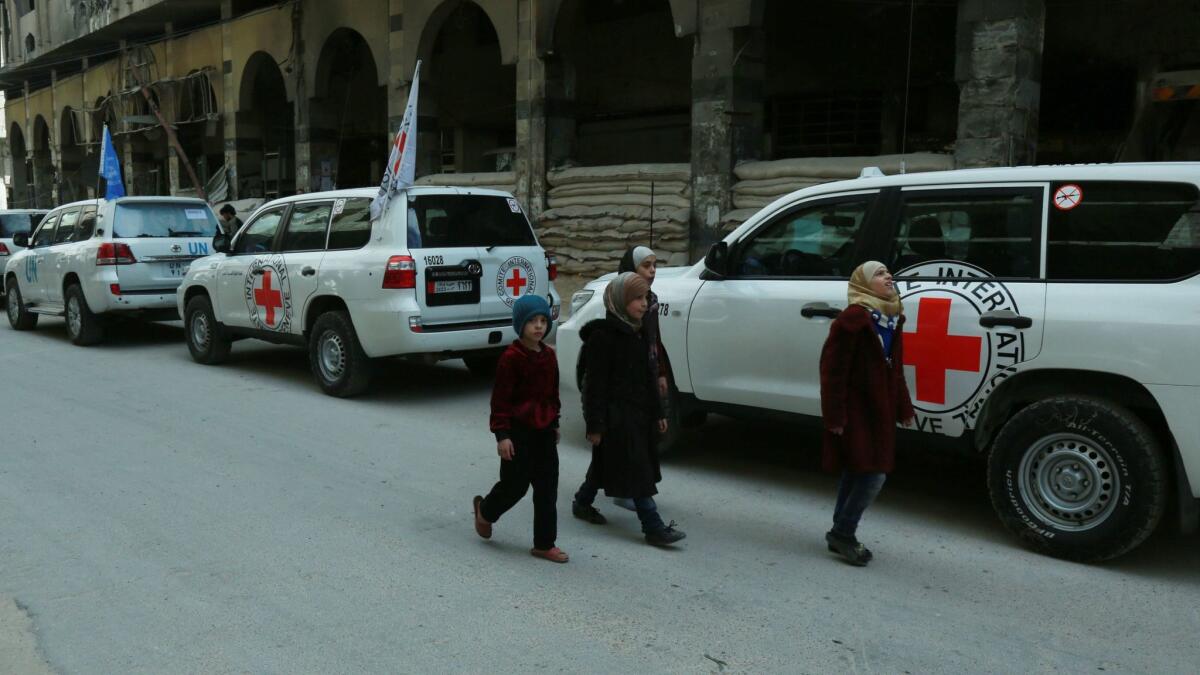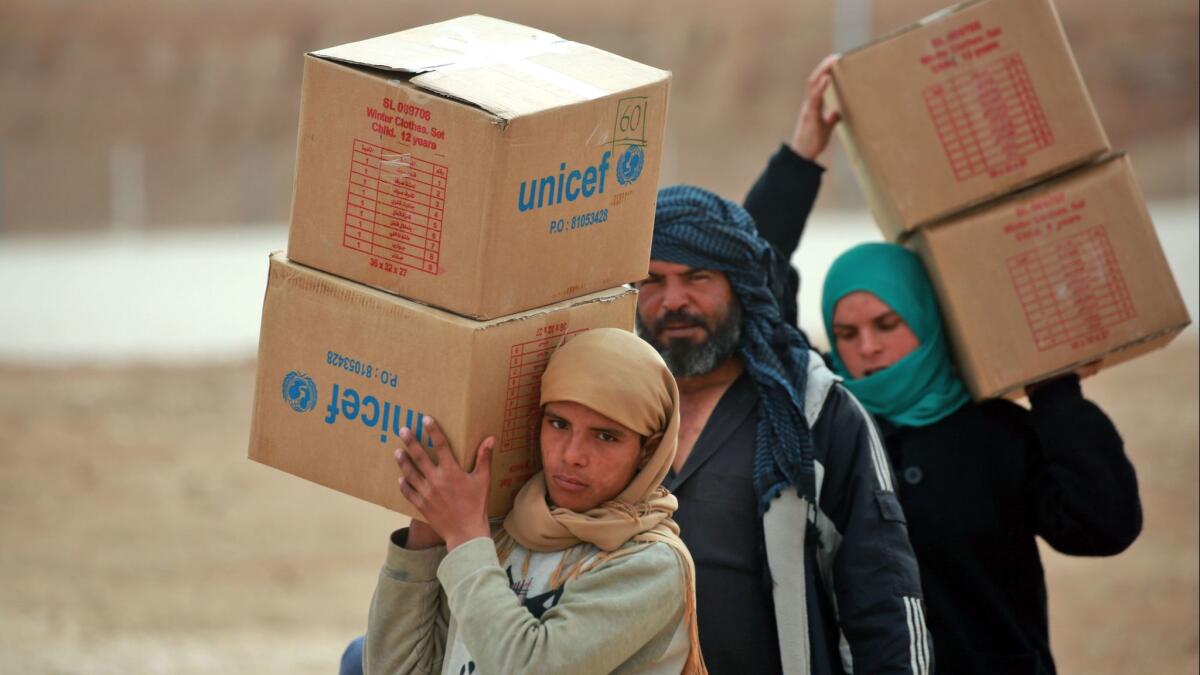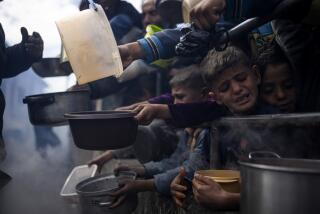They aim to help people in distress, but each year scores of aid workers are killed on the job worldwide

The recent killings of three humanitarian aid workers in Nigeria by suspected Boko Haram militants have sent shock waves throughout the humanitarian aid community and illuminated the increasingly precarious landscape such personnel must navigate to help people in areas of conflict and instability.
But the slayings were not an anomaly.
“Year on year, the number of incidents and the number of victims is, sadly, unacceptably high and steady,” said Adele Harmer, a partner with Humanitarian Outcomes, a research organization based in the United Kingdom that focuses on humanitarian policy and practice and runs the Aid Worker Security Database that records major incidents of violence against humanitarian workers.
On average, 102 aid workers were killed each year from 2006 to 2016, with the highest number of fatalities, 156, recorded in 2013, according to the database. The organization is still verifying figures for 2017 and the first months of 2018, but the raw data show that since the beginning of the year, 23 aid workers have been killed on the job.
Scores more aid workers have been injured over the last 12 years and dozens kidnapped.
Explaining the grim statistics
Jeremy Konyndyk, a senior policy fellow at the Washington-based Center for Global Development, whose research focus includes humanitarian response, said the high casualty count could partly be attributed to the growing size of the aid industry and the rising number of humanitarians working in more risky places, which increases the chances “that something bad will happen,” he said.
“The typical aid environment is no longer an earthquake response or even a drought or famine type of response,” Konyndyk said. “The typical aid environment now really is providing relief in incidents of active conflict and that is an inherently more dangerous context for providing aid than a natural disaster.”
The workers may be affiliated with humanitarian groups, such as the Red Cross or CARE, or participate in efforts organized or run through the United Nations.
Julien Schopp, director of humanitarian practice at InterAction, the largest alliance of U.S.-based international nongovernmental organizations, underscored that the perils were more acute for national staff in the field than expatriates.
“They are more and more on the front line,” Schopp said.
About 2,782 national humanitarian aid workers — those deployed in their own countries — were victims of violent incidents between 2006 and 2016. By comparison, 471 “international” workers — those working abroad — were victims within the same time frame, according to the aid database.
The aid workers killed in the recent assault in Nigeria were all nationals of the West African nation, the U.N. reported. At least eight other people were killed in that attack and a female nurse was feared abducted.
A multitude of perpetrators
The majority of attacks against aid workers occur in a handful of countries.
In 2015 and 2016, South Sudan had the highest number of incidents of violence against humanitarian workers, “reflecting the fracturing conflict and an atmosphere of impunity for armed actors,” Humanitarian Outcomes reported. But consistently over the last four to five years, attacks have occurred in Afghanistan, Syria, Somalia, the Democratic Republic of Congo and South Sudan, Harmer said.
“It’s less a global phenomenon than it is a phenomenon in a set of highly insecure environments,” Harmer said.
And there are a multitude of perpetrators.
For the most part, they are national level non-state armed groups that are seeking control of the state, Harmer said. An example is Boko Haram, which is fighting to topple Nigeria’s government and create an Islamic state under sharia law.
But the aggressors can also be global non-state groups, such as the militant Sunni Islamist organization Al Qaeda and the jihadist terrorist group Islamic State, both of which are multinational.
In addition, aid workers working near war zones are injured or killed during military offensives. For example, aid workers were among dozens of civilians killed through airstrikes by the U.S. and Russia in Syria and Afghanistan, Harmer said.
In 2015 and 2016, 54 aid workers were killed mainly as “the result of airstrikes by Russia and the U.S. in Syria and Afghanistan and an upsurge in state-sponsored violence in South Sudan,” Humanitarian Outcomes reported last year.

Becoming victims while helping victims
There’s rarely one particular reason aid workers fall victim to attacks, aid industry analysts said.
“There are times when these attacks occur to send a message,” said Konyndyk. “There are times when they occur because someone wants to steal something.”
Motives for attacks can also include the desire to control resources and dominate populations, or to undermine a national government by trying to show its inability to protect its people, aid industry observers said. For example, warring parties often target civilian facilities, such as hospitals and schools.
In other instances, attacks may be unrelated to a particular aid agency whose workers get caught in crossfire between local rivals, families settling scores or government forces fighting insurgents.
So while aid workers may be perceived as a soft target, “they’re not always necessarily the targeted group,” Harmer said.
Staying safe is tricky
Unlike embassies and businesses that operate behind high walls, post armed guards or travel in armed vehicles, aid organizations in general rely on what’s called an “acceptance-based approach” to security, industry specialists said.
It’s based on the premise that “if you’re going to operate in an area, you’re doing so with the consent and support of the host population,” said Konyndyk. “Those local communities, as part of accepting [aid groups], enable and support their presence. If there is something dangerous coming down the way, the agency will often have good enough local networks. They will be able to get some advance notice ... and react accordingly.”
If an armed group is trying to win the allegiance of the local population, the group sometimes will leave aid workers alone because their efforts bolster the welfare of civilians. A happier citizenry may then be more welcoming of the armed group. But such reasoning rarely applies to virulently anti-Western aggressors, such as Islamic State and Boko Haram, that often scare local populations into submission and try to force them to reject foreign assistance, aid experts said.
The damaging impact of attacks
A high-profile attack typically prompts organizations to temporarily close down their operations to assess what happened and decide whether it’s safe to resume working in a particular region.
As a result, there is often “an immediate decline in the quality and quantity of aid that reaches populations that are in need,” Harmer said.
Somalia provides a grim example. In 2011 several aid groups pared back or shut down operations there because of stepped-up attacks by the terrorist group the Shabab. In addition, the U.S. had placed counter-terrorism sanctions on aid to Somalia for fear that some humanitarian aid was ending up in the hands of the Shabab. As a result, less aid reached those in need — and just before Somalia was hit by famine.
“There’s a good chance that the descent of a full-on famine could have been halted if aid groups were able to maintain their presence there,” Konyndyk said.
Attacks can also have a chilling effect on the willingness of individual aid workers to go to certain regions, industry analysts said.
The threat of violence means that “sometimes we’re less present in places where we should be, just because we can’t guarantee sufficient security,” Schopp said.
Despite the threats, dozens of humanitarians have continued to operate at full force in some of the most dangerous locales, including in Syria and Yemen, proving that “the aid community does have a fairly robust tolerance for risk,” Konyndyk said.
To read this article in Spanish click here
For more on global development news, see our Global Development Watch page, and follow me @AMSimmons1 on Twitter
More to Read
Start your day right
Sign up for Essential California for news, features and recommendations from the L.A. Times and beyond in your inbox six days a week.
You may occasionally receive promotional content from the Los Angeles Times.







